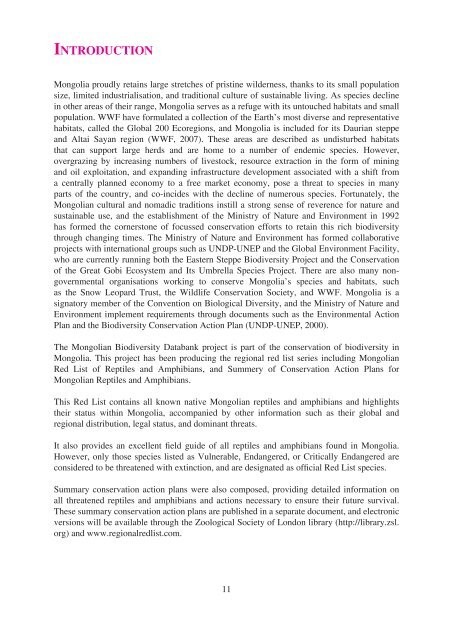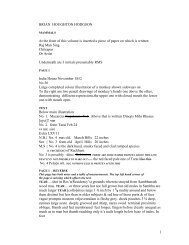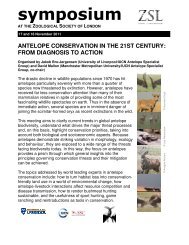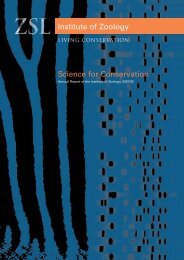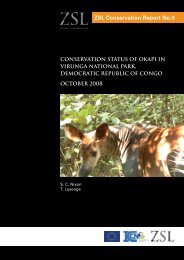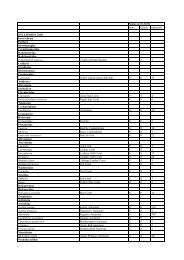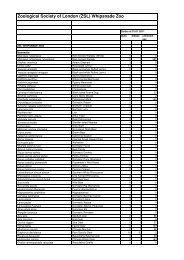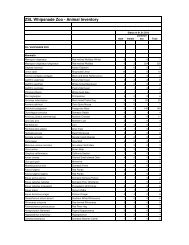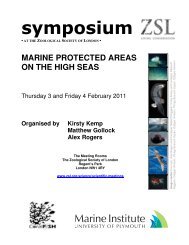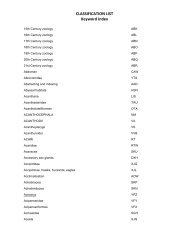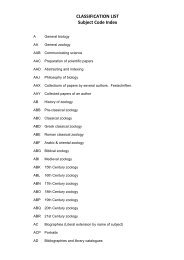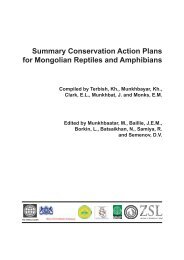Mongolian Red List of Reptiles and Amphibians - Web - Zoological ...
Mongolian Red List of Reptiles and Amphibians - Web - Zoological ...
Mongolian Red List of Reptiles and Amphibians - Web - Zoological ...
Create successful ePaper yourself
Turn your PDF publications into a flip-book with our unique Google optimized e-Paper software.
INTRODUCTION<br />
Mongolia proudly retains large stretches <strong>of</strong> pristine wilderness, thanks to its small population<br />
size, limited industrialisation, <strong>and</strong> traditional culture <strong>of</strong> sustainable living. As species decline<br />
in other areas <strong>of</strong> their range, Mongolia serves as a refuge with its untouched habitats <strong>and</strong> small<br />
population. WWF have formulated a collection <strong>of</strong> the Earth’s most diverse <strong>and</strong> representative<br />
habitats, called the Global 200 Ecoregions, <strong>and</strong> Mongolia is included for its Daurian steppe<br />
<strong>and</strong> Altai Sayan region (WWF, 2007). These areas are described as undisturbed habitats<br />
that can support large herds <strong>and</strong> are home to a number <strong>of</strong> endemic species. However,<br />
overgrazing by increasing numbers <strong>of</strong> livestock, resource extraction in the form <strong>of</strong> mining<br />
<strong>and</strong> oil exploitation, <strong>and</strong> exp<strong>and</strong>ing infrastructure development associated with a shift from<br />
a centrally planned economy to a free market economy, pose a threat to species in many<br />
parts <strong>of</strong> the country, <strong>and</strong> co-incides with the decline <strong>of</strong> numerous species. Fortunately, the<br />
<strong>Mongolian</strong> cultural <strong>and</strong> nomadic traditions instill a strong sense <strong>of</strong> reverence for nature <strong>and</strong><br />
sustainable use, <strong>and</strong> the establishment <strong>of</strong> the Ministry <strong>of</strong> Nature <strong>and</strong> Environment in 1992<br />
has formed the cornerstone <strong>of</strong> focussed conservation efforts to retain this rich biodiversity<br />
through changing times. The Ministry <strong>of</strong> Nature <strong>and</strong> Environment has formed collaborative<br />
projects with international groups such as UNDP-UNEP <strong>and</strong> the Global Environment Facility,<br />
who are currently running both the Eastern Steppe Biodiversity Project <strong>and</strong> the Conservation<br />
<strong>of</strong> the Great Gobi Ecosystem <strong>and</strong> Its Umbrella Species Project. There are also many nongovernmental<br />
organisations working to conserve Mongolia’s species <strong>and</strong> habitats, such<br />
as the Snow Leopard Trust, the Wildlife Conservation Society, <strong>and</strong> WWF. Mongolia is a<br />
signatory member <strong>of</strong> the Convention on Biological Diversity, <strong>and</strong> the Ministry <strong>of</strong> Nature <strong>and</strong><br />
Environment implement requirements through documents such as the Environmental Action<br />
Plan <strong>and</strong> the Biodiversity Conservation Action Plan (UNDP-UNEP, 2000).<br />
The <strong>Mongolian</strong> Biodiversity Databank project is part <strong>of</strong> the conservation <strong>of</strong> biodiversity in<br />
Mongolia. This project has been producing the regional red list series including <strong>Mongolian</strong><br />
<strong>Red</strong> <strong>List</strong> <strong>of</strong> <strong>Reptiles</strong> <strong>and</strong> <strong>Amphibians</strong>, <strong>and</strong> Summery <strong>of</strong> Conservation Action Plans for<br />
<strong>Mongolian</strong> <strong>Reptiles</strong> <strong>and</strong> <strong>Amphibians</strong>.<br />
This <strong>Red</strong> <strong>List</strong> contains all known native <strong>Mongolian</strong> reptiles <strong>and</strong> amphibians <strong>and</strong> highlights<br />
their status within Mongolia, accompanied by other information such as their global <strong>and</strong><br />
regional distribution, legal status, <strong>and</strong> dominant threats.<br />
It also provides an excellent fi eld guide <strong>of</strong> all reptiles <strong>and</strong> amphibians found in Mongolia.<br />
However, only those species listed as Vulnerable, Endangered, or Critically Endangered are<br />
considered to be threatened with extinction, <strong>and</strong> are designated as <strong>of</strong>fi cial <strong>Red</strong> <strong>List</strong> species.<br />
Summary conservation action plans were also composed, providing detailed information on<br />
all threatened reptiles <strong>and</strong> amphibians <strong>and</strong> actions necessary to ensure their future survival.<br />
These summary conservation action plans are published in a separate document, <strong>and</strong> electronic<br />
versions will be available through the <strong>Zoological</strong> Society <strong>of</strong> London library (http://library.zsl.<br />
org) <strong>and</strong> www.regionalredlist.com.<br />
11


